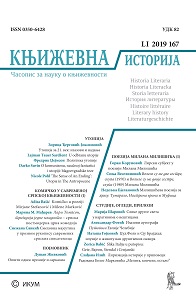Slika Italije u putopisu: Gete, Bajron, Stendal i Crnjanski
The Picture of Italy in a Travelogue: Goethe, Byron, Stendhal, and Crnjanski
Author(s): Zorica BabićSubject(s): Serbian Literature
Published by: Институт за књижевност и уметност
Keywords: travel-related;Italy;textuality;mediation;picture;
Summary/Abstract: By opting for the travel literature on Italy, which was the dominant narrative in the 18th and 19th centuries, and partly the 20th century, as well, the author of the paper wanted to demonstrate how it was constructed, and how important it was,not only for the genre, but for literature and culture in general. For at least five centuries, Italy was the exporter of ideas from very banal ones, related to fashion and cuisine, to artistic, scientific, theological and philosophical. More specifically,the travelogue influenced other genres, even non-literary ones. We have also explored different travel-related traditions: it turns out that the English are not only 300 Zorica Babićthe greatest traditionalists, but also anti-traditionalists. And the French do not recognize, in many ways, the Italian primacy. Furthermore, the author has dealt with the relationship between various travel books, i.e. their authors. And in the end, we could see how important traveling was to them as a biographical fact. Even though it is clear that the experience of a country has always been mediated by literature and deeply «enrolled» in a biographical code. And finally, implicitly and on the basis of the given examples, we make a different, broader and new understanding of the travelogue, or the “travel-related”. This was also caused by the previous approaches that have not exhausted all the possibilities in studying the travel books,such as narratology, iterology, or travel culture. And closer to him the travel discourse. The author thinks that it is necessary to talk about the “travel-related”, as itis about a novelistic, poetic, or fictional one. Therefore, it is necessary to start from the attribute, i.e. quality. It turns out that the travelogue is an emphasis, essentially an intertextual genre. The travel-related is also found in other genres: novels, memoirs, essays, scientific studies, but also in the works of those who are not even writers, psychoanalysts Freud and Jung. It turns out that Jung never arrived in Rome,which has far-reaching consequences for us: the supremacy of Freud over Jung is noted, and his excellent knowledge of travel literature. Here are further individually analyzed travel canons, Goethe and Stendhal, then Byron and Crnjanski, as well as the relationship between them. We consider the influence of Goethe on Stendhal,Winckelmann on Goethe, and De Sade, then de Staël’s on Byron and Stendhal. And Finally, the influence of Dostoevsky, Stendhal and Casanova on Crnjanski. The Conclusion is that experience is always mediated by literature.
Journal: Књижевна историја
- Issue Year: 51/2019
- Issue No: 167
- Page Range: 279-300
- Page Count: 22
- Language: Serbian

